Main Characteristics of Egyptian Assryian and Archaic Greek Art
A wide multifariousness
Egyptian artists used a wide array of materials, both local and imported, from very early in their history. For instance, already in the Predynastic menstruation nosotros find figurines carved from lapis lazuli—a lustrous blueish stone that originates in what is now Afghanistan and indicates the early on presence of robust merchandise routes.

Group of stones collected in Egypt showing the range of colors and textures available to the ancient artists.
Rock

Menkaure (Mycerinus) and Khamerernebty(?), graywacke, c. 2490-2472 B.C.Eastward. (Museum of Fine Arts, Boston)
In that location were numerous native stones used for statuary, including the ubiquitous soft limestone of the desert cliffs that line most of the Nile valley, too as sandstone, calcite, and schist.
Harder stones include quartzite, diorite, granite, and basalt. Carving on softer stones was done using copper chisels and rock tools; hard stone required tools of even so harder rock, copper alloys, and the use of abrasive sand to shape them. Polishing was achieved with a polish rubbing rock and abrasive sands with a fine grit.
Painted bronze
Most statuary was painted; even stones selected for the symbolism of their color were ofttimes painted. For instance, the exemplary statues of Menkare, builder of the smallest of the iii major pyramids at Giza, were executed in nighttime schist (also called greywacke). This smooth black stone is connected with Osiris, resurrected god of the expressionless who was oft shown with black or green skin referring to the fertile silt and lush vegetation of the Nile valley.
These images preserve traces of red paint on the king'south skin indicating that, when completed and placed in his memorial temple about his pyramid, they would take appeared lifelike in coloration. With time, the pigment would accept flaked abroad, revealing the blackness stone underneath and explicitly linking the deceased male monarch with the Lord of the Underworld.
Wood
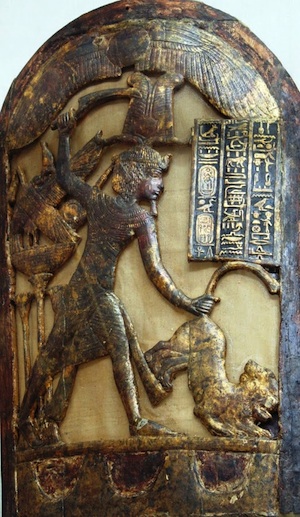
Ceremonial gilded wooden shield from the tomb of Tutakhamun. Egyptian Museum, Cairo (New Kingdom) (photograph: Dr. Amy Calvert)
Egyptian artists likewise used a variety of woods in their piece of work, including the native acacia, tamarisk, and sycamore fig too as fir, cedar, and other conifers imported from Syria. Artisans excelled at puzzling together pocket-sized, irregular pieces of wood and pegged them into identify to create bronze, coffins, boxes, and piece of furniture.
Metals
They also executed pieces in diverse metals, including copper, copper alloys (such as bronze), gold, and silver. Cult statues of gods were made in gilded and silver—materials identified past myth as their skin and bones—and were frequently quite small. Very few metal statues survive because they were often melted down and the cloth reused, although preserved examples from the Old and Middle Kingdoms demonstrate that they were skilled not only in canvas metal forming, just also good complex casting.

Tutankhamun's lunar pectoral in the Egyptian Museum, Cairo (New Kingdom) (photograph: Dr. Amy Calvert)
Jewelry work was quite sophisticated even in the Old Kingdom, every bit demonstrated past some highly creative pieces depicted in tomb scenes. A cache of royal jewelry from the tombs of Middle Kingdom princesses displays extremely high levels of skill in terms of design as well as precisely cut stone inlays, repoussé, and cloisonné
Many objects, specially minor amulets and inlays, were made from a manufactured fabric known equally Egyptian faience. This quartz-based medium could be hands shaped, molded, and mass produced. The glaze blanket could be nearly any colour, depending on the minerals used in the composition, although turquoise bluish is the near common.
Relief sculpture
Relief was usually carved earlier existence painted. The ii primary classes of relief are raised relief (where the figures stand up out from the surface) and sunk relief (where the figures are cut into and below the surface). The surface would be smoothed with a layer of plaster and then painted. If the surface was not carved before painting, several layers of mud plaster would be applied to create a apartment plane.
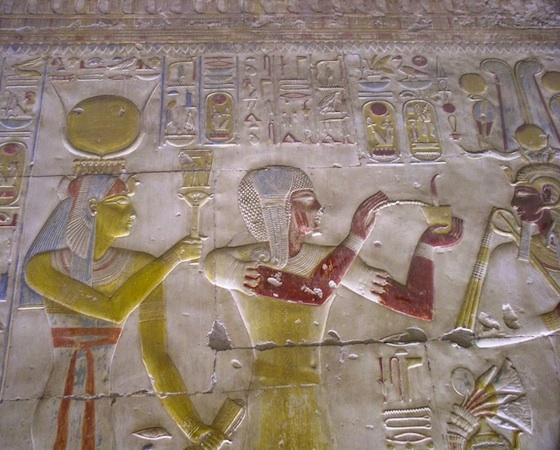
Painted raised relief in the Temple of Seti I at Abydos (New Kingdom)
The drawing surface would be delineated using gridded guidelines, snapped onto the wall using cord coated in cherry pigment dust (very much like chalk lines used by modern carpenters). This grid helped the artists properly proportion the figures and lay out the scenes. Scene elements were drafted out using red paint, corrections noted in black paint, and and so the painting was executed ane color at a time. Even on carved relief, many elements in a scene would exist executed only in paint and not cut into the surface.

Iron oxide nodules, source of a range of cerise pigments, Thebes
Pigments
Most pigments in Egypt were derived from native minerals. White was often made from gypsum, black from carbon, reds and yellows from iron oxides, blue and light-green from azurite and malachite, and bright yellow (representing gold) from orpiment. These minerals were basis and then mixed with a establish or animal based glue to make a medium able to attach to the walls. They could be applied equally a unmarried plane, but were as well layered to create subtle effects and additional colors, such as pink or grayness.
Additional resource:
About quarrying
Paint like an Egyptian activeness
Color symbolism in ancient Egypt
Nicholson, P. & Ian Shaw, Ancient Egyptian Materials and Technology (Cambridge University Press, 2000)
Smarthistory images for didactics and learning:
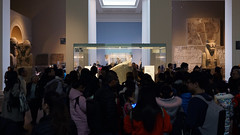
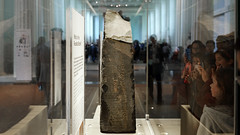
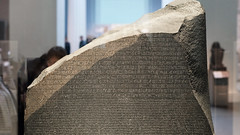
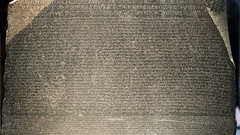
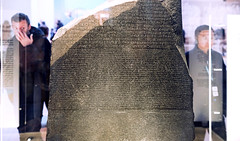

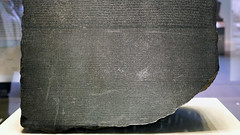
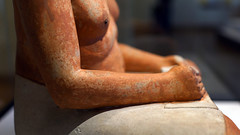
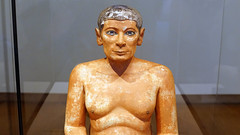


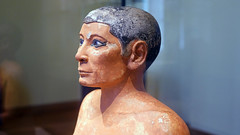
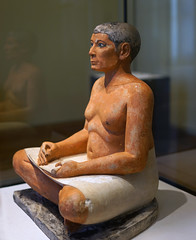
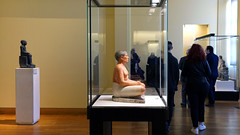
More Smarthistory images…
Source: https://smarthistory.org/materials-and-techniques/
0 Response to "Main Characteristics of Egyptian Assryian and Archaic Greek Art"
Post a Comment